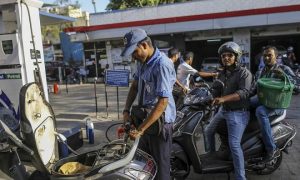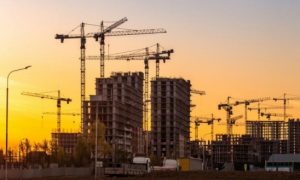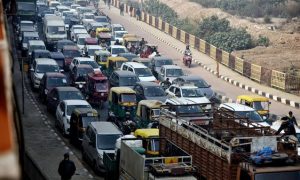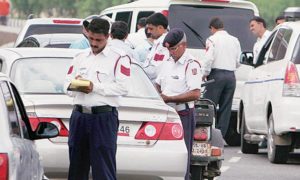Union Budget 2023: While the pandemic has jacked up India’s health spend, the challenge for the fiscally constrained government is to keep the pace.
To illustrate, while the government (the Centre plus the states) expenditure on health, as a percentage of the GDP, had marginally risen from 1.2% in FY17 to 1.35% in FY18 before falling again to 1.28% in FY19. In FY22, it stood at 2.1%, as per the last Economic Survey. It is unlikely that public spending on health has risen from that level in the current fiscal, given the estimates in the Central and state Budgets.
The country’s overall spending on health, which had fallen to 3.75% of the GDP in 2013 to 3.01% in 2019, but is expected to have reached close to 4% in FY22 as per some health sector watchers — a level last seen nearly 20 years ago.
Read More: Cryptos Are Nothing but Gambling, Their Value Only Make-Believe: RBI Governor
The National Health Accounts estimates for 2018-19 (the latest such data available) also seemed to have some positive news, in that out-of-pocket expenditure (OOPE) for households fell from over two-thirds of total health expenditure in FY 14 to 48.2% in FY19. With a focus on increasing health spending following the pandemic, the share of OOPE in total health expenditure is likely to have come down further.
But as distinguished professor at the Public Health Foundation of India K Srinath Reddy and his Bhubaneswar-based colleague Sarit K Rout pointed out in an opinion article in this newspaper, these need to be read against both India’s low overall health spending, as even at a 4% level, it seriously lags the US’ 16.8% (2019) and the global average of 9.8% and the universal health coverage (UHC) goal. The World Health Organisation and the World Bank both have stated that countries will need to push OOPE down to 20% if they are to achieve UHC.
Against this, what most experts seek from the upcoming Budget is an expansion of the Centre’s health spend. The last two fiscals have been a somewhat positive indication. But the fact is that, even though the share of the government in total health expenditure has increased from 23.2% to 34.5% from FY14 to FY19 with a concomitant increase in its health spend on a per capita basis, the needle has not moved meaningfully on the Centre’s contribution to overall government spending on health. This is not to say that it has to have a greater share of the burden, but even as states are exhorted to get ambitious on their health spending, the Centre too must move in tandem.
Read More: Adidas loses court battle against designer Thom Browne in 4-Stripes logo debate
There is almost a policy consensus that the public spending on health must rise much faster to be at par with the global average. The 15th Finance Commission had said such spending should rise to 2.5% of GDP by 2025. However, even this won’t take the country anywhere near a reasonable level of pubic expenditure in this key area of development.
“The Budget must build on the initiatives launched during the Covid period for strengthening the health system and connect them coherently to pre-existing programmes, by using the Ayushman Bharat platform,” says Reddy. Another focus area has to be primary care, he adds. “Primary care must be prioritised, especially the previously neglected component of urban primary care. District hospitals and medical colleges should be connected to primary care through efficient telehealth, referral and transport systems. These can be routed through the National Health Mission, which needs a higher allocation”.
The Pradhan Mantri Jan Arogya Yojana (PM-JAY), the government’s flagship health expenditure coverage scheme for the poor, could also be extended to cover outpatient care and essential medicines. Against the FY22 Budget Estimate (BE) of Rs 6,400 crore for PM-JAY, the FY23 BE stood at Rs 6,412 crore. Spending, though, may be considerably lagging given the revised FY22 estimate was a low Rs 3,199 crore. This would suggest there is room to extend coverage to outpatient care, as experts have suggested.
With the Covid pandemic exposing the weak public health infrastructure of the country, the Centre will likely continue to pump in more investments in primary health centres, district hospitals, wellness centres and national ambulance infrastructure. Steps will also likely be announced in the Budget to bridge the shortfall in the health workforce. But the rate of increase in public health spending via Budget would still far short of the requirements. The 15th Finance Commission had recommended that India’s public expenditure on health should increase to 2.5% of GDP by 2025.
There are indications that the Centre may widen the coverage of PM-JAY which offers Rs 5-lakh-a-year free health cover to 107 million poor households, to large sections of the middle-class families to protect them from health-related expenditure shocks. Currently, the scheme is for the poor and vulnerable families, covering nearly the bottom 40% population of the country, which are identified based on select deprivation and occupational criteria in rural and urban areas respectively, via the socio-economic caste census (SECC) 2011.
It is also likely that the middle-class may be required to pay a nominal fee to be covered under PM-JAY.
Ahead of the Budget, the talks of a universal basic income (UBI) scheme have gained some traction too. In a recent interview to FE, Niti Aayog member Ramesh Chand suggested that the government should convert the Pradhan Mantri Kisan Samman Nidhi (PM-Kisan), the income support scheme for farmers, to a UBI scheme that includes other weaker sections such as farm labourers,
construction workers and non-farm labourers. Other subsidies could be subsumed with UBI in a phased manner, so that the UBI doesn’t become an unsustainable fiscal burden, he said.
Under PM-Kisan launched in February 2019, Rs 6,000 is annually transferred to each farmer’s direct benefit transfer (DBT)-linked bank account in three equal instalments, irrespective of their land holdings. The number of beneficiaries crossed 110 million from 31 million at the beginning of the scheme.
The Economic Survey 2016-17 indicated that the UBI deserves a careful examination. The move, aimed to wipe out poverty in the country, will bring down the poverty level to 0.5% in the country but will cost 4-5% of the gross domestic product, the Survey had noted. The idea was UBI would replace all subsidies and provide cash direct benefits to individuals.
(With inputs from Prasanta Sahu)



































